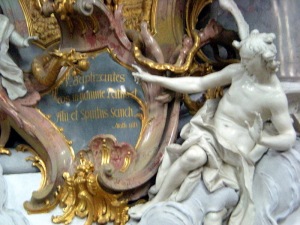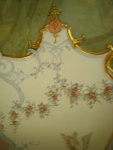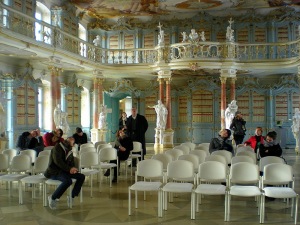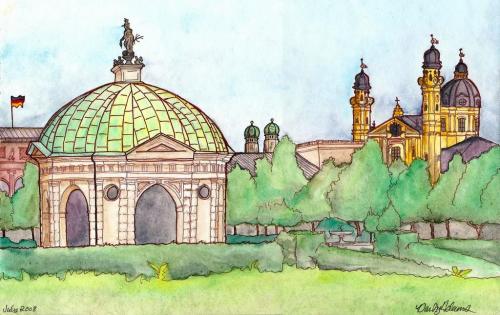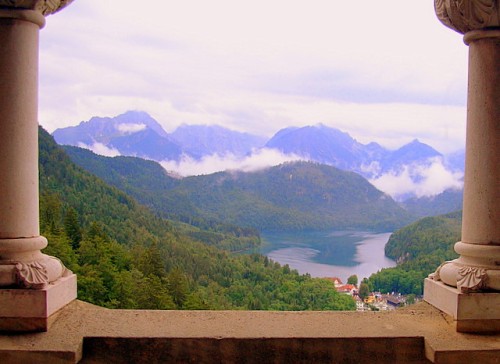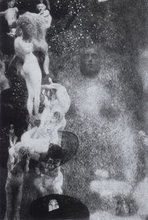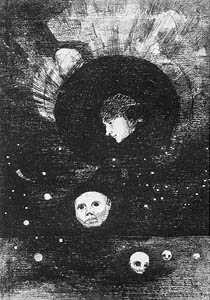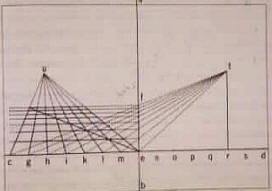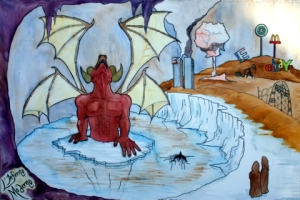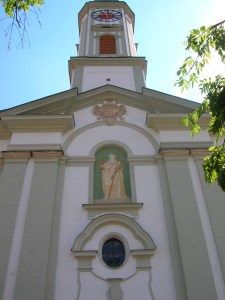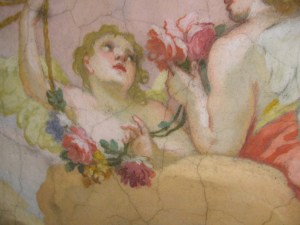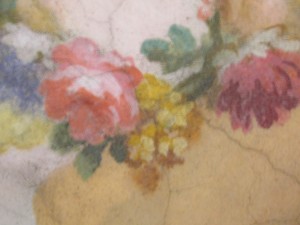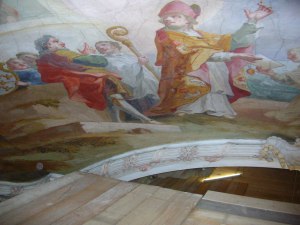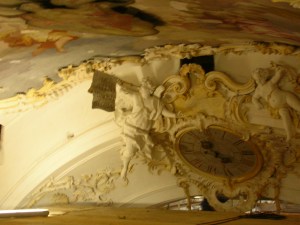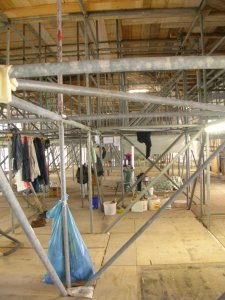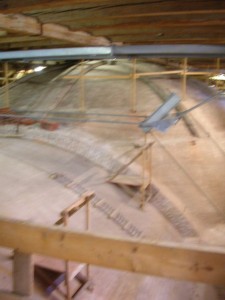About a month ago I went on an excursion with “Historische Kunst- und Bilddiskurse” (my Master’s program) to academically celebrate the end of the semester. First we had a project seminar in Höchstädt (actually in the palace there!) and then we continued on a overview adventure of Baroque churches in Bavaria, particularly those from Dominikus Zimmerman and his brother Johann Baptist Zimmerman. I don’t think I’ll go into detail about each church (could be a little over the top and most definitely repetitive), so I’ll list them all now, in case you care to google them: Kloster Maria Medingen, the Frauenkirche in Günzberg, Kartause Buxheim, Residenz and Kirche Kempten, Steingaden, Steinhausen (yep, that’s somewhere else!), the Wieskirche (you may have heard of that one…it’s protected by UNESCO), the beautiful library and church in Bad Schussenried, Ottobeuren (a name I’ll never forget), and the Johanneskirche in Landsberg an der Lech.
The thing I liked most about this excursion was the spectrum in which we explored, which allowed me to finally understand the difference between Baroque and Rococo architecture. Apparently the transition mainly took place in none of than the (then) country of Bavaria. I’ll get to that more specifically in just a bit…
Here’s the palace in Höchstädt where we spent about 10 hours a day in a workshop:
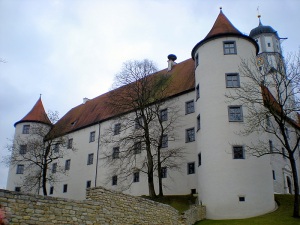 I have to say, I can’t really complain about the location! We also had a few breaks during the workshop in which we were given tours of the palace, which is partially restored and still undergoing the remaining restorations. In this wing we saw the restored frescoes:
I have to say, I can’t really complain about the location! We also had a few breaks during the workshop in which we were given tours of the palace, which is partially restored and still undergoing the remaining restorations. In this wing we saw the restored frescoes:
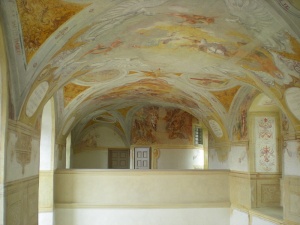
I actually quite liked this restoration, as it did not have the goal of bringing the works back to their original quality by adding what was missing, but instead restored what was there and nothing more. It leaves the frescoes with a very rustic and authentic look. I was also quite amused that this wing of the palace actually housed a chapel for weddings! I was quite appealed myself, until it was pointed out that the frescoes in the chapel portray the Fall from Eden! Yikes! Get married and you’re thrown from Paradise! Actually, come to think of it, maybe the irony is, in fact, a good omen. Sort of a way to ward off those demons from the start.
Since we’re on the subject of the Fall, here’s a picture of some Baroque decorative sculpture from the church in Ottobeuren:
Now that’s some pretty cool decorative sculpture of an angel turning away from a dragon-like serpent trying to give it the apple, the forbidden fruit! This was one of the cooler things in Ottobeuren that had to do with “cool” meaning interesting, but all in all, Ottobeuren was “cool” in the cold way! As we tried to leave the village in our two Mercedes buses, a blizzard came, and the bus I was in, along with 7 of my fellow students, got stuck in the snow! The bus literally slid off the road! We had to sit in a Thai food restaurant until the blizzard passed and then we took a taxi back to Kempten, where we were staying. It turned out the bus we had had “all-weather” tires instead of snow tires…and if anyone ever tell you that there isn’t a difference between the two, tell them to talk to us! In an case, the situation seems funnier in hindsight and it was quite a bonding experience for us students!
In our homebase during the excursion, Kempten, we saw the Residenz and Baroque church. Upon entering the Residenz, we had to wear felt shoes because of the inlay wood floors (also from the period!)…here’s a picture:
The Residenz was one of the prime examples we saw of the distinction between Bandelwerk, signifying Baroque design, and Rocaille, characteristic of Rococo decoration. To put a name to the face, or a guess an image to the Stuck, or plaster with which these ornaments were made:
To the left you see the Bandelwerk, which means ribbon work…very elegant and perhaps more my personal taste. (I would suggest clicking on the thumbnails to see the larger photos…these things are very detailed!) On the right is the Rocaille, actually a French word describing a type of shell, which is why it has the shell-like and sea-creature form.
The Residenz in Kempten was a restored example of these architectual ornamentations. In this picture you can see a small section that the restoration workers did not restore, as a point of reference/comparison:
 Restoring to the original colors really shows the artwork’s brilliance! It seems so dull otherwise!
Restoring to the original colors really shows the artwork’s brilliance! It seems so dull otherwise!
In addition to learning about the architectural/ornamental styles and the relevance of restoration, I also gained some knowledge of Catholic iconography. (I know, I should know these things…I just never had much connection with religions) For example, each Gospel (Matthew, Mark, Luke, and John) apparently have animal symbols: an angel, eagle, ox, and lion (in the same order). I also learned the holy monograms, like the IHS for Jesus and this cool one for the mother Mary:
It creates the name “Maria.”
So, I’ve saved the best for last…in Bad Schussenried we visited an old convent, itself quite pretty, but hidden in one of its wings was the most beautiful library I have ever seen! As an exception to the churches, monasteries, and convents that we had seen elsewhere, this library did not have religious iconography, but iconography from the 18th/19th century of the science and humanities! Each corner of the library was dedicated to a different discipline: art, sculpture, architecture, and music! It even had an early for of the scientific classification system portrayed as branches in a tree in the fresco on the ceiling! Here are the pictures:
I love this picture! All of the students are staring up at the fresco…in a way looking to the sky! as Dr. Frangenberg describes the iconography. (He’s the one standing in the back…our Baroque and Rococo expert)
And, of course, a picture of me proudly standing in the spectacle:
 Yay! I’m so happy that I finally have this post done! It took me like, a month! My apologies once more for the delay…coming soon: Unsinniger Donnerstag in Mittenwald and Paris!
Yay! I’m so happy that I finally have this post done! It took me like, a month! My apologies once more for the delay…coming soon: Unsinniger Donnerstag in Mittenwald and Paris!
